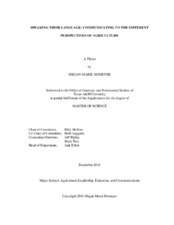| dc.contributor.advisor | McKim, Billy R. | |
| dc.contributor.advisor | Leggette, Holli | |
| dc.creator | Homeyer, Megan Marie | |
| dc.date.accessioned | 2017-03-02T16:49:45Z | |
| dc.date.available | 2018-12-01T07:21:01Z | |
| dc.date.created | 2016-12 | |
| dc.date.issued | 2016-12-05 | |
| dc.date.submitted | December 2016 | |
| dc.identifier.uri | https://hdl.handle.net/1969.1/159062 | |
| dc.description.abstract | A communication gap exists between the general public and the agricultural industry. To begin bridging the communication gap, agricultural communicators need to understand the different types of audiences and perspectives of agriculture that exist. The overall purpose of this study was to begin to understand the public’s perspectives of agriculture and develop better methods of understanding perspectives. Therefore, this study was split into two aims, and each aim was reported separately. The first aim was a mixed-methods study to develop agricultural personas and used three methods of data collection: qualitative interviews, Q sorts, and quantitative questionnaire. The second aim was a methodology study to develop Q sort syntax for SPSS® that reported results equivalent to PQMethod, a popular Q sort analysis software. The sample consisted of 13 purposively selected individuals from the Millennial generation in Central Texas and remained the same throughout the study. The participants were selected based on opinions and thoughts about agriculture.
The Q sort analysis produced four factors that were developed into agricultural personas by combing the data from all three methods. The four personas gave a basic understanding of agricultural perspectives and how individuals relate to each other in relation to their opinions and thoughts toward agriculture. Communicators and marketers can use these personas to better understand their target audience and tailor information to them. These personas are the foundation of agricultural personas and need to be researched further before they can be generalized to a larger audience.
The Q sort syntax developed for SPSS® was successful and produced results that were equivalent to PQMethod analysis with no statistical differences. Social science researchers interested in perspectives and types of people can use the syntax to analyze Q data in SPSS®. | en |
| dc.format.mimetype | application/pdf | |
| dc.language.iso | en | |
| dc.subject | Perspectives of agriculture | en |
| dc.subject | Persona | en |
| dc.subject | Communication methods | en |
| dc.subject | Q sort | en |
| dc.subject | SPSS Syntax | en |
| dc.title | Speaking Their Language: Communicating to the Different Perspectives of Agriculture | en |
| dc.type | Thesis | en |
| thesis.degree.department | Agricultural Leadership, Education, and Communications | en |
| thesis.degree.discipline | Agricultural Leadership, Education, and Communications | en |
| thesis.degree.grantor | Texas A & M University | en |
| thesis.degree.name | Master of Science | en |
| thesis.degree.level | Masters | en |
| dc.contributor.committeeMember | Ripley, Jeff | |
| dc.contributor.committeeMember | Troy, Mark | |
| dc.type.material | text | en |
| dc.date.updated | 2017-03-02T16:49:45Z | |
| local.embargo.terms | 2018-12-01 | |
| local.etdauthor.orcid | 0000-0003-4487-8408 | |


